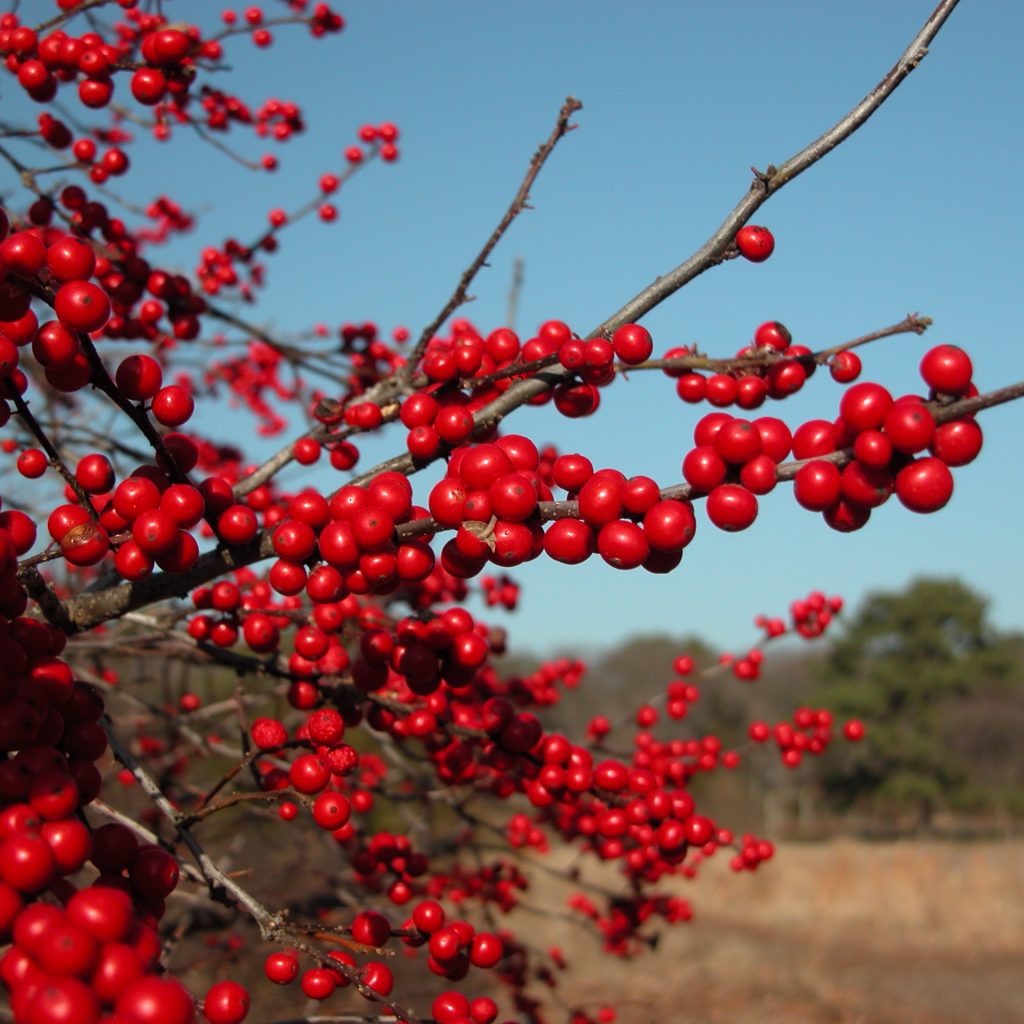Winterberry – A Holly Like No Other
Written by Director of Horticulture Les Parks

Winterberry is not a difficult plant to grow, it thrives in our climate, and it is not typically bothered by pests or diseases. Even deer and rabbits tend to ignore them. They do well in full sun to partial shade, though too much shade will reduce flowering and consequently reduce fruiting. They will also do well in the wetter areas of your garden and don’t mind the poor drainage that is detrimental to so many other plants. Once they are established they can even take a bit of drought.
There are several selections of winterberry available, including some with orange or yellow fruit for the non-traditionalist. The ultimate size of the plant varies by selection, and there are even some dwarf varieties available. The most important thing to consider when selecting winterberry varieties is pollination. Specific female plants must have a specific male plant for pollination. If the flowers on each sex are not open at the same time in spring, pollination will not occur, so use the chart below to play matchmaker. One male can pollinate many females as long as they are within 50’ of each other.
Winterberry has a lot going for it. It is native; attracts pollinators; feeds the birds; it is easy to grow; and it is a beautiful addition to the landscape, especially in winter when we need bright color. On top of all that, you could also make a little money on the side from them. Just in time for the holidays, cut winterberry branches are sold at the florist for about $15-20 apiece! At that price, a few stems will more than pay for the cost of the plant, not that you should need any additional incentive to plant this holly like few others.
| Winterberry Chart | |||
| Female Varieties | Size | Fruit | Pollinated by |
| Afterglow | 3-6′ T&W | red orange | Jim Dandy |
| Aurantiaca | 5′ T&W | orange-red aging to orange-yellow | Jim Dandy |
| Berry Heavy® | 6-8′ T&W | large, bright orange red | Mr. Poppins® or Jim Dandy |
| Berry Heavy® Gold | 6-8′ T&W | large, bright gold | Mr. Poppins® or Jim Dandy |
| Berry Nice® | 6-8′ T x 3-4′ W | bright red | Jim Dandy |
| Berry Poppins® | 3-4′ T*W | bright red | Mr. Poppins® |
| Bonfire (hybrid) | 8-12′ T x 10-12′ W | masses of small red berries | Jim Dandy |
| Cacapon | 5′ T&W or more | heavy fruiting, true red | Jim Dandy |
| Chrysocarpa | 7′ T&W | naturally occurring yellow berries | Jim Dandy |
| Goldfinch | 3-7′ T&W | gold | Jim Dandy |
| Harvest Red (hybrid) | 10′ T x 15′ W | large, deep red | Raritan Chief |
| Little Goblin® Orange | 3-4′ T&W | bright orange | Little Goblin® Guy |
| Little Goblin® Red | 3-4′ T&W | bright red | Little Goblin® Guy |
| Oosterwijk | 4-6′ x 6-8′ | bright red | Southern Gentleman |
| Red Sprite | 3-5′ T&W | dense clusters of bright red berries | Jim Dandy or Apollo |
| Shaver | 5′ T&W | orange-red | Jim Dandy |
| Sparkleberry (hybrid) | 12′ T&W | large, bright red | Apollo |
| Stoplight | 8’T&W | deep red | Jim Dandy |
| Sunsplash | 6-7′ T&W | orange-red fruit, variegated foliage | Jim Dandy |
| Winter Gold | 7′ T&W | pinkish orange aging to yellow | Southern Gentleman |
| Winter Red | 6-8′ T&W | abundant, bright red | Southern Gentleman, Apollo, Raritan Chief |
| Male Varieties | Size | ||
| Apollo (hybrid) | 10-12′ T&W | ||
| Jim Dandy | 3-6′ T x 4-8′ W | ||
| Little Goblin® | 4′ T&W | ||
| Mr. Poppins® | 4′ T&W | ||
| Raritan Chief (hybrid) | 4-5′ T x 6-8′ W | ||
| Southern Gentleman | 6-9′ T&W |




